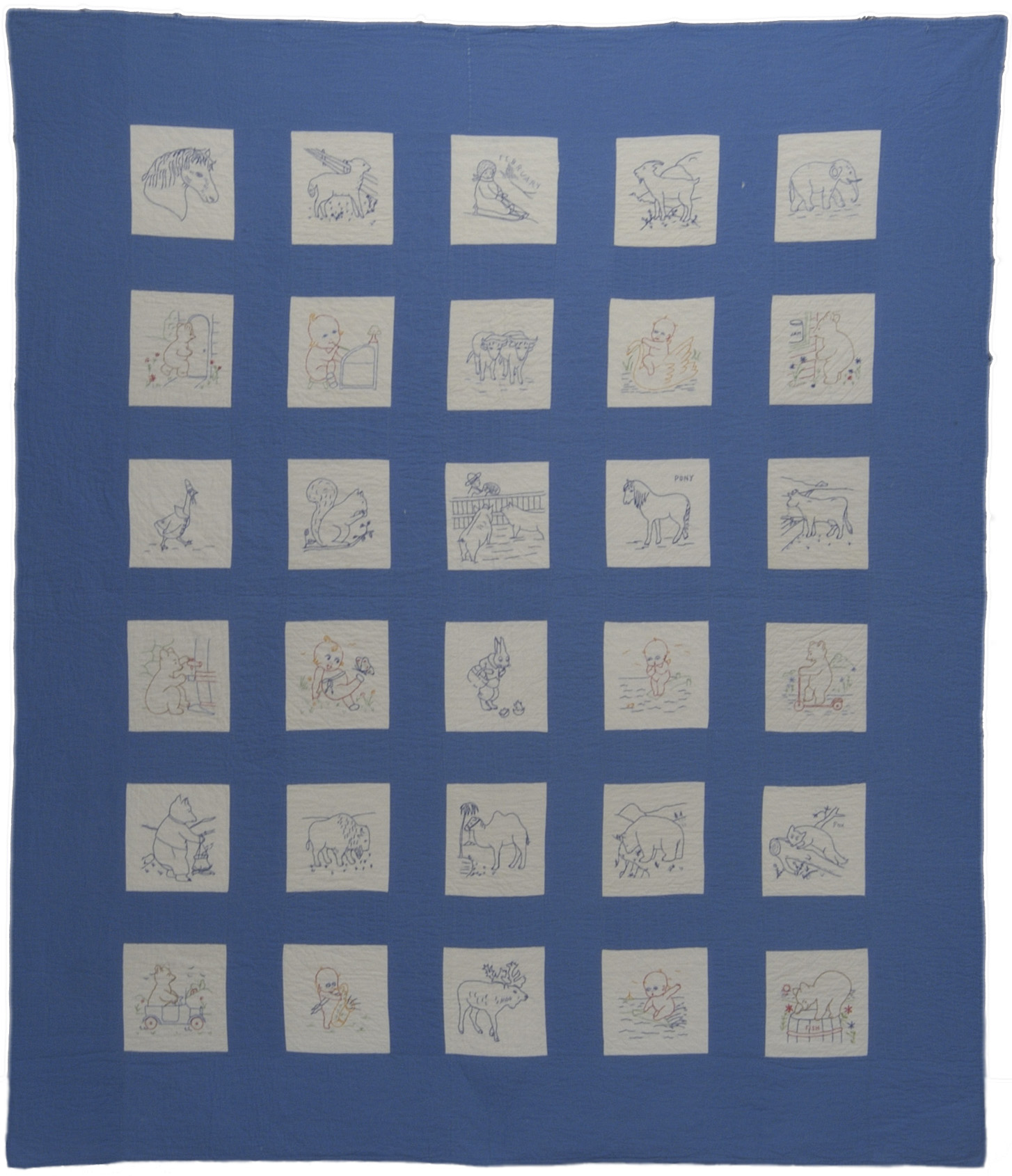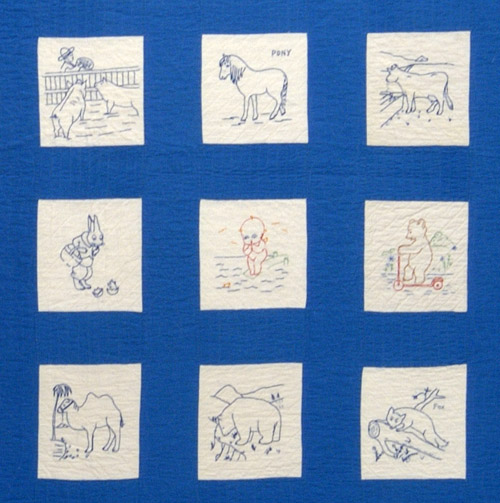
QUILT INDEX RECORD
12-8-7720
Who documented this quilt?
Michigan Quilt Project; Michigan State University Museum Collection
Where are the records for this quilt housed?
Michigan State University Museum
Michigan Quilt Project Number:
85.2118
If this quilt is owned by a museum, enter the accession number:
6119.12
Object label:
Boy's Quilt
Emilie Ann Clarke
Detroit, Michigan
1924-35
Detroit, Michigan
Deborah Harding Redwork Collection, Michigan State University Museum, acc.#6119.12
Essay:
The Clarke Family quilt collection, given to Michigan State University Museum in 1986 by Dr. Harriet A. Clarke and her brother, George M. Clarke, includes forty-five quilts and quilt tops completed between 1926 and 1946 by Bozena Vilhemina Clarke, her daughter Laura May Clarke, and daughter-in-law Emilie Ann Clarke. The collection also includes numerous hand-made templates and patterns, unique hand-colored graphs of planned quilts, newspaper and magazine clippings, and personal inventory notes written by the quilters. Because the Clarke quilt collection represents virtually the entire output of quilts made by one family over a 20-year period and the supplemental materials reflect the entire quiltmaking process from inception to completion, it offers a unique glimpse into the quilting lives of one family. The collection also provides an excellent study example for understanding quilting activity in Detroit during this period and the relationship of the Clarke family quilters to the regional and national rejuvenation of interest in quiltmaking and home arts of the 1920s to the 1940s.
For a pair of children's quilts, Emilie Clarke pieced together squares featuring outline embroidered pictorial images. This quilt, known by the family as the "Boy's Quilt," features designs rendered mostly in blue embroidery floss. After World War I, colorfast cotton embroidery threads became available in a variety of colors. As other dye colors became more stable, outline in other colors became increasingly popular. Post-1910, bluework, or all blue embroidery designs, became more common. Emilie completed a companion quilt, known as "Girl's Quilt" whose designs include florals, "kewpies," and sunbonnet figures.
Quilt's title:
Embroidered Squares #1
Owner's name for the quilt:
Children's Quilt Boys
Quilt top made by:
Clarke, Emilie Ann
Quilted by:
Clarke, Emilie Ann
If you are the quilt owner, how did you acquire this quilt?
Received as a gift
Where the quilt was made, city:
Detroit
Where the quilt was made, county:
Wayne
Where the quilt was made, state:
Michigan (MI)
Time period:
1901-1929
Quilt is presently used as:
Museum collection
Quiltmaker's gender:
Female
Quiltmaker's city:
Detroit
Quiltmaker's county:
Wayne
Quiltmaker's state:
Michigan (MI)
Quiltmaker's maiden name:
Arnold
Quiltmaker's birth date:
5/14/1897
Quiltmaker's date and place of death:
1/19/1976
Quiltmaker's ethnic background/tribal affiliation:
German, French
Quiltmaker's educational background:
M.D. from University of Michigan in 1922, PhD in Public Health from Wayne State University in 1937
Quiltmaker's religious affiliation:
Congregational
Quiltmaker's occupation:
Public Health Department for the State of Michigan, the Red Cross.
Quiltmaker's father's name:
Arnold, Francis Christian
Quiltmaker's father's ethnic/tribal background:
French, German
Quiltmaker's mother's name:
Arnold, Emma L. (nee Vogelsang)
Quiltmaker's mother's ethnic/tribal background:
German
Quiltmaker's marriage date(s):
8/31/1923
Quiltmaker's spouse's/spouses' and /or partner's/partners' name(s):
Clarke, George Robert
Quiltmaker's spouse's/spouses' and/or partner's/partners' ethnic/tribal background:
Bohemian, English
Quiltmaker's spouse's/spouses' and/or partner's/partners' occupation:
Electrical Engineer
Number of children:
3
How many of the quiltmaker's children were girls?
1
How many of the quiltmaker's children were boys?
2
How did the quiltmaker learn to quilt?
From Relative
When did the quiltmaker learn to quilt?
Age 20-29
Other notes on how the quiltmaker learned, and how and why they quilt:
Emilie made quilts in the 1920s for her children. Her career took over in the 1930s.
Estimated number of quilts made by this quiltmaker:
5-20 quilts
Does/did the quiltmaker sell quilts?
no
Does/did the quiltmaker teach quilting?
no
Does/did the quiltmaker belong to a group? Name of the group?
For awhile she quilted at the Boulevard Congregational Church.
Where does/did the group meet?
At the corner of Warren and West Grand Boulevard in Detroit, Michigan.
What are the main activities of the group?
This group sewed together to make items for church bazaars. They sold
This is a:
Finished quilt
How wide is the quilt?
74
How long is the quilt?
86
Shape of edge:
Straight
Shape of corners:
Straight
What color is the quilt?
White
Overall color scheme:
Two color
Quilt's condition:
Fair/worn
Damage:
Stains; Tears or holes
Type of inscription:
Date
What is inscribed on the quilt?
1924-1935
Method used to make the inscription:
Attached label; Embroidery
Describe the method used to inscribe the quilt:
Cross stitch
Location of inscription:
on back
Describe the quilt's layout:
Block pattern
Number of quilt blocks:
30
Size of quilt blocks:
8 x 8
Arrangement of quilt blocks:
Straight
Spacing of quilt blocks:
Separated by plain sashing
Sashing width:
4 1/4
Number of borders:
1
Describe the borders:
8"
Fiber types used to make the quilt top:
Cotton
Fabric styles used in the quilt top:
Solid/plain
Piecing techniques used to make the quilt top:
Hand Piecing
Can you feel or see paper on the quilt that was used as a construction aid?
no
Embellishment techniques used to make the quilt top:
Embroidery
Embellishments used:
Cotton thread
Materials used to make the back:
Cotton
Number of pieces of fabric in the quilt back:
3
Describe the back:
Same fabric used throughout
Materials used in the quilt binding:
Cotton
How is the binding made?
Straight grain
What is the width of the binding (measure on the top only)?
less than a half inch
What kind of filling is used in the quilt?
Cotton
How thick is the quilt?
Thin (Less than 3/16?)
How are the layers held together?
Hand quilting
Number of quilting stitches per inch, place 1:
9
Number of quilting stitches per inch, place 2:
9
Can you see any knots on the front or back of the quilt?
no
Quilting designs used, overall motifs:
Grid diamond; Single parallel lines
Quilting designs used, decorative motifs:
Cables
Quilting designs used, background fills:
Parallel lines
Where did the maker get their materials?
Purchased new
Where did the maker find their pattern?
Commercial/Published source: Pattern
Related items such as diaries, obituaries, wills, household inventories, or pictures of the quiltmaker:
Pattern pieces, oral interviews with quilt makers daughter. See 6119.62, pattern pieces for Children's Quilt Boys and Bloomer Girls.
Person filling out this form is:
Quilt owner
Ownership of this quilt is:
Public- Michigan State University Museum
Quilt owner's name:
Michigan State University Museum
Quilt owner's city:
East Lansing
Quilt owner's county:
Ingham
Quilt owner's state:
Michigan (MI)
Quilt owner's country:
United States
How was this quilt acquired?
Gift
Tell the story of how the quilt was obtained:
This quilt was inherited by Harriet and George Clarke,from their mother Emilie Clarke, the quiltmaker. Harriet and George then donated it to the MSU Museum in December of 1985.
Details
Access and copyright information:
Restricted
The quilt was made to be used for:
Bedding, daily use
Describe any favorite patterns, tools, etc. used by the quiltmaker:
She shared patterns with her family members.
Describe any unique traditions, quilting related customs, beliefs, songs or rhymes used by the quiltmaker:
Emilie made quilts by herself and occassionally quilted with her mother. Her mother-in-law was a prolific quilter and her sister-in-law also quilted. Her daughter Harriet remembers her mother had her mother-in-laws old quilting frame set up in the attic and quilted during the spring and fall when the whether allowed her to work in the unheated, un air conditioned space. One summer her Grandma Arnold quilted with her mother in the dining room.
Who photographed this quilt?
Fumio Ichikawa
Copyright holder:
MSU Board of Trustees
Cite this Quilt
Clarke, Emilie An. Embroidered Squares #1. 1901-1929. From Michigan State University Museum, Michigan Quilt Project; Michigan State University Museum Collection. Published in The Quilt Index, https://quiltindex.org/view/?type=fullrec&kid=12-8-7720. Accessed: 04/26/24
-
Exhibit
Redwork: A Textile Tradition in Americ...
Michigan State University Museum
-
Collection
Clarke Family Quilt Collection
Michigan State University Museum
